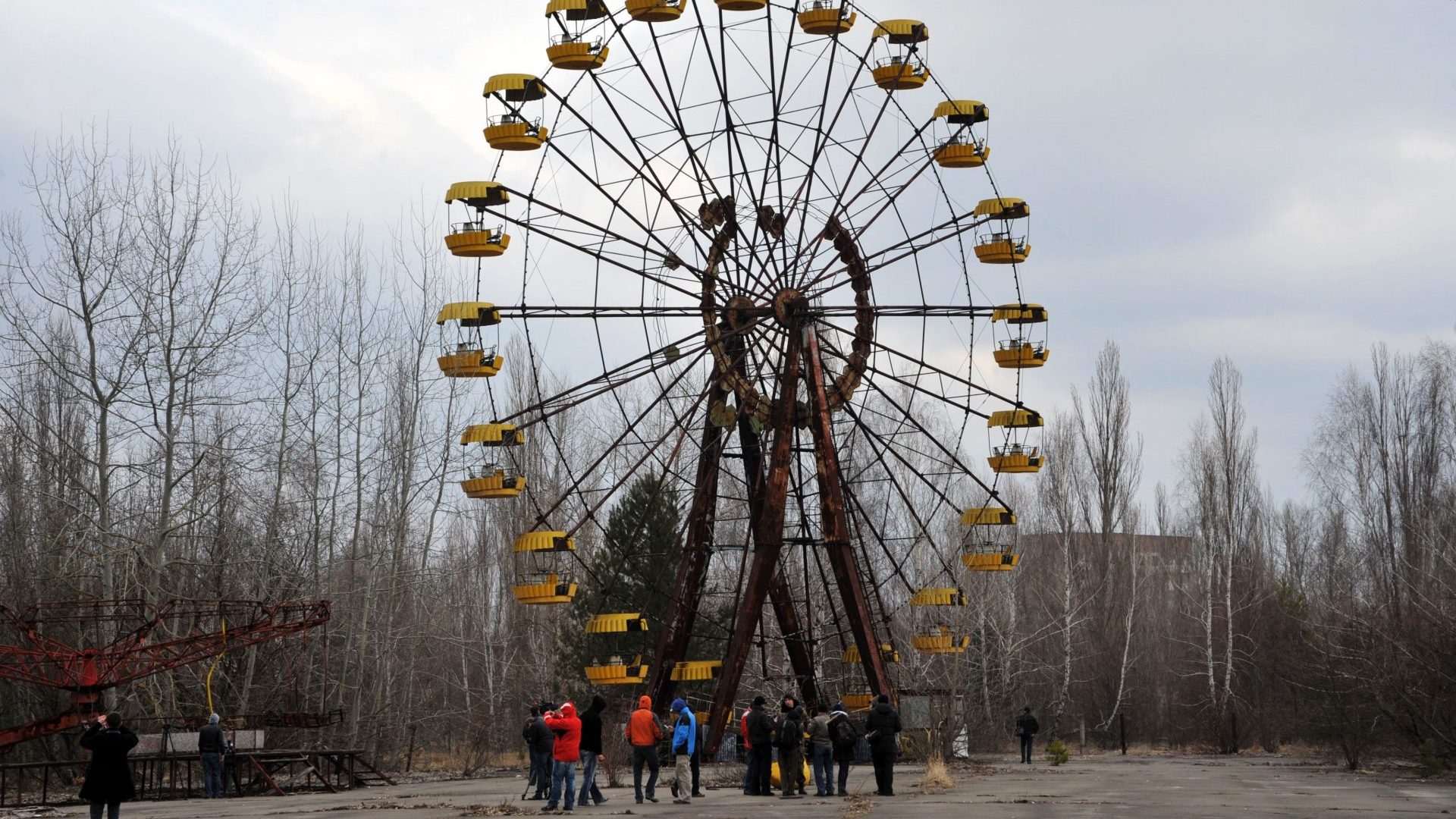They took all the kettles. That was weird. What was even weirder was that
they left behind all the base plates needed to make the kettles work.
One of the most alarming aspects of early reports of Russia’s attempted
invasion of Ukraine was how on the first day of the invasion they targeted
the Chernobyl nuclear power plant close to the Ukrainian border with Belarus. No sooner had Russian forces rolled across the border than troops
were descending on the plant where, 36 years after the worst nuclear accident in history, 3,000 people are still employed in monitoring the
effects of the 1986 explosion and processing spent nuclear fuel that arrives from all over Europe.
The night shift was coming to an end on February 24 when Russian soldiers arrived from Belarus, marched into the plant and announced they were taking over. Nobody was sure why a near-derelict and still highly toxic nuclear power plant was an early priority for Putin’s forces. There was propaganda talk that the Ukrainians were using Chernobyl to make a dirty
bomb but the military top brass surely didn’t believe that?
Either way, that unfortunate night shift remained permanently on duty as
best they could for the next five weeks until the Russians suddenly packed up and left in a tearing hurry.
It could be that some troops were already displaying signs of radiation sickness. They’d charged through the exclusion zone as if unaware of how
dangerous it was and they thundered through what’s known as the Red Forest apparently oblivious to the most toxic piece of ground in Europe, if not the world. A pine forest at the time of the accident, the trees had absorbed massive amounts of radiation, turned red, died and were buried where they’d stood, making the Red Forest the most radioactive part of one of the most radioactive areas in the world.
When the ground is undisturbed a person on the Red Forest site can absorb a year’s worth of safe levels of radiation in 24 hours. If they kick up any dust that amount increases dramatically. Driving tanks and trucks across it throws up a lot of dust, vastly increasing the risks of radiation poisoning for those in the vehicles. But the Russians went one better than that: they dug trenches in the Red Forest and used the displaced soil to fill sandbags and build gun emplacements.
The damage inflicted on the plant by the Russians won’t really be known until the end of the war, but so far the inventory of stolen equipment includes 700 computers, 350 vehicles and 1,500 Geiger counters. And the kettles, of course. Every electric kettle in the place was taken, but none of the base plates that make them work.
Before the invasion the Chernobyl exclusion zone had become an unlikely tourist destination. In 2019, the last year before the pandemic, 124,000 people participated in official guided tours of Prypyat, the ghost town once home to 50,000 people. That figure was nearly three times the 46,000 who visited just two years earlier: the 2018 HBO series dramatising the disaster brought flocks of sightseers.
Even before the television series the plant and Prypyat had become almost as familiar to us as places we’ve actually visited. The red and white capped chimney that became the most recognisable symbol of the plant, the school classrooms with children’s drawings still fixed to the mildewing walls, the empty swimming pool, the rusting Ferris wheel, offices with desks and chairs still just as they were when their occupants last stood up from them more than 30 years ago.
This familiarity of the forbidden has made Prypyat, according to a remarkable new book about the region, “twice dead”. Killed first by the accident, then more recently “bored hipsters shot Prypyat dead with their
expensive cameras; rich girls from the capital soiled the rotten couches with
their tattooed backs and mapped every nook of the terra incognita on Instagram”.
Stalking the Atomic City: Life Among the Decadent and the Depraved of Chernobyl by the Ukrainian writer Markiyan Kamysh was first published in Ukraine in 2015, its new English translation commissioned by Pushkin Press long before the invasion. It details Kamysh’s many years of travelling illegally in the Chernobyl exclusion zone, wandering among the abandoned villages for weeks at a time, sometimes alone, sometimes with a girlfriend, occasionally with eager tourists who persuade him to take them into what he calls simply
the Zone.
Kamych is a self-described “stalker” of the Zone, one of a handful of individuals who go there not to gawp, not to feel the thrill of being somewhere forbidden and not even to rummage around looking for stuff to take away and sell. In fact for most of the book it’s hard to pinpoint exactly why he keeps returning to such a bleak, uninviting region and staying for long periods. It’s roasting hot in summer and freezing in winter. He’s beset by midges in the heat of the swamplands, then is swimming through chest-deep snow, drinking vodka on waking at 6am because it’s the only liquid that doesn’t freeze.
He writes of slurping down water from muddy ponds, sharing accommodation with the decomposing carcasses of dead wolves that “smell like tiramisu” and walking 28 miles to a particular village where “only the jackals go, besides us” just because he knows there’s a makeshift stove there. A Year in Provence this is not.
Kamysh, who is part of “the generation the same age as the explosion”, began his incursions into the Zone about a decade ago and identifies with a third wave of illegal visitors to the beleaguered region. In the 1990s, “Prypyat was packed with daredevils, bums, deserters, looters and fugitives. They hid in the villages for months, munching on rotten apples and dreaming of hunkering down until all the troubles of the world melted away”. Then “hooligans from the capital” arrived, stealing items from homes and public
buildings to sell at street markets.
His people came next, those to whom “the Zone became a land of tranquillity and frozen time”, a place to hang out and relax, “better than the seaside, the Carpathians… or the chilled Turkish resorts drowning in chilled mojitos”.
It’s a book infused with melancholy. The decay Kamysh documents is almost Gothic in scale, especially after a hard winter when the physical decline of places that were once communities, places of light and warmth, is particularly obvious. Anywhere else these houses, schools, shops and offices would be reclaimed by nature. Here nature’s emergence from the toxic ground feels almost malevolent, not so much a reclamation as a devouring.
It is difficult to see the attraction, not least when Kamysh describes the blisters from endless walking, the insect bites, the run-ins with the police and the time he unwittingly sets up camp in a building where lynxes have installed a litter of cubs and are vicious about defending them against intruders.
He admits that almost every time he returns home to Kyiv he promises himself it’s the last time and he’ll never go back. But he does go back, and he
knows he is exceptional in being drawn repeatedly to a dead zone “Normal people have no business in a radioactive dump,” he writes. “Remember this.”
Why does he do it? It’s left largely unsaid but his father, a physicist, was one of the ‘liquidators’ sent to Chernobyl in 1987, months after the explosion, to monitor radiation levels and oversee the early stages of the clean-up. Kamysh was born a year later and his father died when he was 14, as a direct result of exposure to the site.
He’s a child of Chernobyl, it’s been there since his conception, it’s there at the core of his being like the reactor core lurking beneath its thick concrete casing at the heart of the Zone. It’s as if he’s pulled back to the region because they have the same polluted DNA. In this profound and understated duel with grief, ennui and uncertainty, Kamysh has written a surprisingly meditative book entirely lacking in anger or bitterness about what Chernobyl did to his father and what might yet lay in store for him.
“When people ask me about my health, I really have no idea what to tell them,” he says, believing that “in two decades I will meet those boys and
girls who kept me company during my travels around the Zone in the
chemotherapy room of a nice cancer clinic in Kyiv”.
What the future holds for any further explorations of the Zone by
Kamysh is anyone’s guess right now. He must miss it terribly. It seems likely
the Russian soldiers, most of whom professed ignorance of the 1986 disaster and even the nature of the facility they were occupying, may well be the spawning of a new generation of stalkers to come, an increasingly ancient disaster lurking in their very make-up.
Stalking the Atomic City: Life Among the Decadent and Depraved of Chernobyl by Markiyan Kamysh, translated by Hanna Leliv and Reilly Costigan-Humes, is published by Pushkin Press on July 7, price £12.99




